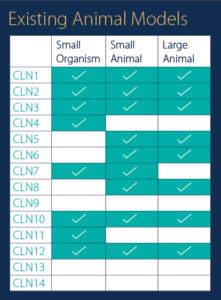Model systems are an important part of disease research. These model systems can range from simple single cellular systems to larger animal models. The BDSRA has helped to fund many of these animal models to further today’s research programs in therapy development. In the chart below we have outlined what models have been developed for each form of Batten disease.
 Some of the small organisms that have been used to study Batten disease include zebrafish, yeast, and fruit flies. These models are a useful tool because their genome can be easily manipulated, they reproduce extremely quickly, and share enough genetic material with humans to help researchers investigate the cell biology of many neurodegenerative diseases.
Some of the small organisms that have been used to study Batten disease include zebrafish, yeast, and fruit flies. These models are a useful tool because their genome can be easily manipulated, they reproduce extremely quickly, and share enough genetic material with humans to help researchers investigate the cell biology of many neurodegenerative diseases.
Historically murine, or mouse, models have played an important role in understanding the neurobiology of neurodegenerative genetic disorders. They are a logical step from studying the disease in flies or zebrafish. Mouse models are useful because they are easy to handle, have high reproductive rates and are inexpensive to maintain compared to larger animal models. Mouse models have been used to study the underlying mechanisms and progression of the disease which helps to develop novel therapies. They can also be used to identify reliable biomarkers and to test potential therapies and small molecule drugs.
Large animal models are important to the study of Batten disease and other neurodegenerative diseases because their brain anatomy more closely resembles the human brain (compared to mouse models and small organism models). Also, the progression of symptoms in the large animal model is more similar to that of humans in part because of their longer lifespan. These large animal models are important to understanding the pathophysiology and biochemistry of Batten disease. Recently they have been used to test drug therapies for enzyme replacement and gene therapy.
Citations:
Faller, K. M., Gutierrez-Quintana, R., Mohammed, A., Rahim, A. A., Tuxworth, R. I., Wager, K., & Bond, M. (2015). The neuronal ceroid lipofuscinoses: Opportunities from model systems. Biochimica et Biophysica Acta (BBA) – Molecular Basis of Disease, 1852(10), 2267-2278
Weber, K., & Pearce, D. A. (2013). Large Animal Models for Batten Disease. Journal of Child Neurology, 28(9), 1123-1127


